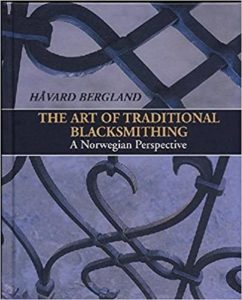The Art Of Traditional Blacksmithing: A Norwegian Perspective
By: Håvard Bargland – Published: 2011

Price : $$ – Amazon
Philip’s Ranking: 5
Beginner Blacksmith: 5
Advanced Blacksmith: 3
Inspiration: 3
Historical: 2
Video Review: N/A
I picked this book up randomly when Centaur Forge was closing it’s Austin location and had everything on sale. I was shocked by how great this book is. The book itself is beautiful, the photographs are all great, and the subjects it covers I find fascinating. This is probably my favorite blacksmithing book I’ve read so far.
Håvard does a great job providing both a great general blacksmithing reference and highlighting the Norwegian blacksmithing history and tradition.
The book starts off with a history of blacksmithing in Norway including some great photos of charcoal kilns being constructed to make massive amounts of charcoal for blacksmiths. He then moves onto the pretty standard parts of a forge but dedicates some much appreciated space to the topic of smoke draft and forge hoods which any solid fuel smith who has a poorly ventilated workspace will tell you is a critical subject.
There is a chapter on the typical hand tools of a blacksmith. While every blacksmithing book has a similar chapter Håvard again goes beyond most other books providing extra details, excellent photographs, and great hand drawn illustrations that make the topic clear while providing extra details.
The next chapters cover materials, heat treatment, and then forging techniques and tools. Each subject is covered to the right depth and the mix of photographs and hand drawn illustrations allows Håvard to provide the right visuals to best drive home the written descriptions. With the basics out of the way a series of basic forging exercises are provided and these are all well presented, suitable for a new blacksmith, and beautiful projects. There are a number of trivets and pot rests which I quiet like. Håvard is also clearly of the opinion that forge welding is a basic blacksmithing skill and I applaud the fact that he uses forge welds in this beginner projects as it’s a skill every blacksmith should have and be comfortable using.
After the 32 pages of basic projects Håvard moves on to a full 56 pages on the forging of woodworking tools. He covers everything from gouges and scoops to multiple axes and knives. Attention is paid not just to the forging but also on how to handle and sharpen the tools with the normal clear illustrations and photos.
Chapters 8 and 9 are both focused on power hammers and tools for power hammers and look like a great primer for the subject.
The final third of the book covers Hinges and Hardware, Locks and Hardware, Restoration Blacksmithing, Artist Blacksmithing, Forging Figures, and Sketching your ideas, and then photos from European hammer-ins. This section is simply amazing when you are looking for inspiration. The punch and chisel techniques on the antique hinge hardware is stunning. The locks are beautiful and explained in enough detail that I really want to try making one. The sketches and photos from the hammer-ins are all simply inspiring.
Overall I can’t say enough positive things about this book. I highly recommend it and for any new smith this and Mark Aspery’s Skills of a Blacksmith Vol 1 would be the first two books I would recommend. Neither are the cheapest options out there but the value per dollar you spend makes these books a steal.